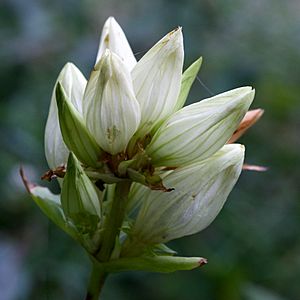Plain gentian facts for kids
Quick facts for kids Plain gentian |
|
|---|---|
 |
|
| Conservation status | |
| Scientific classification | |
| Genus: |
Gentiana
|
| Species: |
alba
|
The Plain Gentian (Gentiana alba) is a beautiful flowering plant. People also call it the pale, white, cream, or yellow gentian. It belongs to the Gentianaceae family, which is known for its pretty flowers.
This plant grows yellowish-white flowers. These flowers come from thick, white roots that grow deep into the ground. The Plain Gentian is found in North America. Its native home stretches from Manitoba and Ontario in Canada, all the way south to Oklahoma, Arkansas, and North Carolina in the United States.
Contents
What Makes Plain Gentian Special?
The Plain Gentian is a special plant. In some parts of its range, it is quite rare. This means it might be hard to find in those areas. Sometimes, it is even listed as endangered or threatened. This means there are not many left, and people are working to protect them.
How Plain Gentian Looks
The Plain Gentian is a plant that stands upright. It has a strong stem and its flowers are a lovely yellowish-white color. These flowers are usually more open at the top compared to some other gentians.
Plain Gentian vs. Bottle Gentian
The Plain Gentian looks a lot like another plant called the Bottle Gentian (Gentiana andrewsii). Both plants grow in many of the same places. However, there are some key differences:
- Bottle Gentian flowers are blue, while Plain Gentian flowers are yellowish-white.
- Bottle Gentian plants tend to be less upright.
- Plain Gentian starts to bloom a few weeks earlier in the year.
- The flowers of the Plain Gentian are more open at the top. Bottle Gentian flowers often stay closed, looking like a bottle.
Mixing Plant Types: Hybrids
Sometimes, the Plain Gentian and the Bottle Gentian can mix. This is called hybridizing. When they hybridize, they create new plants. These new plants can be a mix of both parents. For example, you might see plants that grow upright like the Plain Gentian. But their flowers might be white with blue edges, showing traits from both parents.
See also
 In Spanish: Gentiana alba para niños
In Spanish: Gentiana alba para niños


